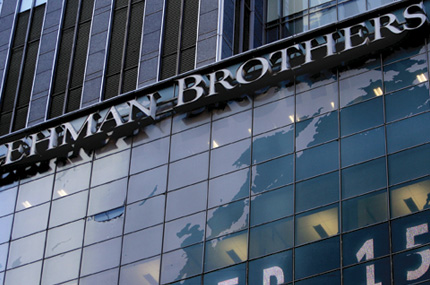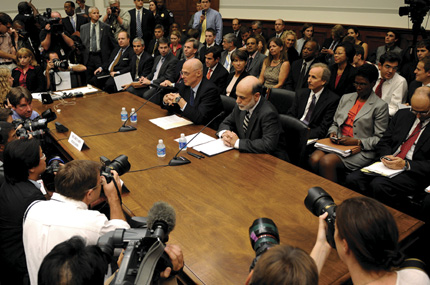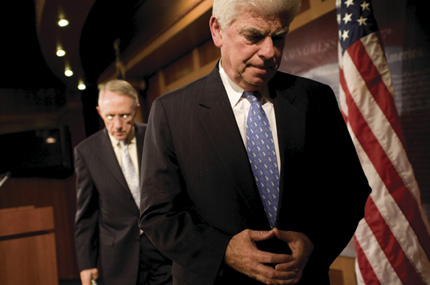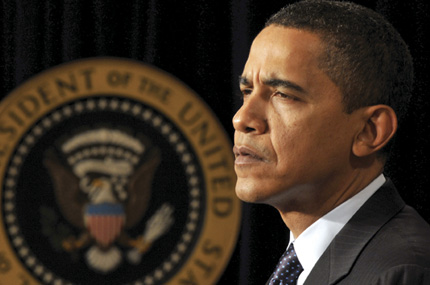Crisis Timeline
2007
01.07 - 03.07
More than 25 U.S. subprime mortgage lenders go
bankrupt.
04.07
New Century Financial Corp., the nation’s second-largest
subprime mortgage lender, fails. Most believe it is just an isolated incident.
06.07
Two highly leveraged Bear Stearns hedge funds invested in subprime asset-backed securities plunge in value, then shut.
Merrill Lynch, a creditor, can’t find buyers for the funds’ assets, revealing their worthlessness. The crisis begins to spread…
08.07
Hedge funds experience
massive meltdowns
in one week.
French bank BNP Paribas freezes the short-term lending market as popular investment vehicles are revealed to be supported by toxic subprime assets, erroneously rated triple-A.
Crisis goes global: France, China, and others report subprime-related losses.
09.07
The federal reserve starts cutting rates.
Banks start hoarding, lending interbank only overnight, rather than the conventional three months.
10.07
Banks begin writing down
billions of dollars
in mortgage-backed derivatives.
2008
01.08
U.S. stocks fall 8%
amid the largest drop in U.S. home
sales in 25 years.

03.08
After a run on Bear Sterns,
the government arranges JPMorgan Chase’s
purchase of the
investment bank by guaranteeing $29 billion in toxic securities.
07.08
FDIC seizes Indymac
in one of the largest bank
failures
in U.S. history.

09.07.08
Fannie Mae and Freddie Mac
experience huge losses in their
$5.2 trillion
debt portfolios,
creating a systemic risk. The government puts them
into conservatorship and replaces their leaders.
09.15.08
158-year-old Lehman Brothers,
with $639 billion in assets, files for the
largest bankruptcy
in U.S. history
Merrill Lynch sells itself to Bank of America, amid fears that it’s insolvent. Prices of Morgan Stanley and Goldman Sachs stock and derivative securities reflect belief they are near failure; their creditors demand more collateral.

09.16.08
Reserve Primary Fund,
one of the largest
money-market mutual funds, seizes up
as its $785 million of Lehman Brothers short-term paper becomes nearly worthless.
Massive uncertainty causes a run on the money-market system, the primary source of short-term funding. In the most serious event of the crisis, the Fed steps in to guarantee all money-market funds.
09.17.08
Similar collateral calls on AIG prompt the Fed
to inject $85 billion into the giant insurer,
fearing failure would be catastrophic.
Federal Reserve Chairman Ben Bernanke and Treasury Secretary Henry Paulson call for a massive bank bailout.

09.19.08
The $700 billion
Troubled Asset Relief Program (TARP)
is unveiled.
09.21.08
Goldman Sachs and
Morgan Stanley
convert to bank holding companies,
ending the era of the investment bank.
09.28.08
Washington Mutual
is seized by FDIC, then
sold to
JPMorgan Chase.
09.29.08
Wachovia
enters crisis takeover talks with Citigroup and is then bought by Wells Fargo
after the IRS sweetens the deal with a tax subsidy.
10.03.08
Congress passes an amended bailout bill.
10.09.08
Global powers coordinate an interest-rate cut as
the crisis deepens.
10.10.08
U.S. stocks post worse week in century
as DOW drops by almost one-quarter amid
concern about government missteps on the crisis.
The Fed announces an additional $900 billion is available to banks.
11.07.08
The U.S. announces its
heaviest job losses
in 14 years.

11.10.08
Government doubles funds
commited to AIG.
11.24.08
The Treasury gives Citigroup
$20 billion in TARP funds
and guarantees $306 billion of assets in exchange for warrants and preferred stock.
2009
01.09
JPMorgan Chase
announces fourth quarter 2008
profits fell 75%.
A Congressional Oversight Panel questions the
way TARP has spent its billions. The Treasury
purchases about $7 billion in stock from troubled U.S. banks.
02.09
Congress passes a $787 billion stimulus package, mostly along party lines. Treasury Secretary
Timothy F. Geithner unveils a rescue plan.

03.09
DOW drops below 7,000 for first time since 1997.
Anger swells after AIG reveals that it paid
$165 million
in bonuses
to the very employees responsible for its troubles,
some of whom no longer work for the insurance giant.
The Fed announces plan to buy up treasury bonds
and other securities, effectively pumping
$1 trillion into the economy.
Geithner announces plan to drastically
tighten financial industry regulations.

PHOTOS FROM TOP: ©KEVIN STURMAN; ©BRYAN ALLEN/CORBIS; ©PETER FOLEY/EPA/CORBIS;©SHAWN THEW/CORBIS; JUSTIN LANE/EPA/CORBIS; ©BRENDAN HOFFMAN/EPA/CORBIS; RON SACHS/POOL/CNP/CORBIS








